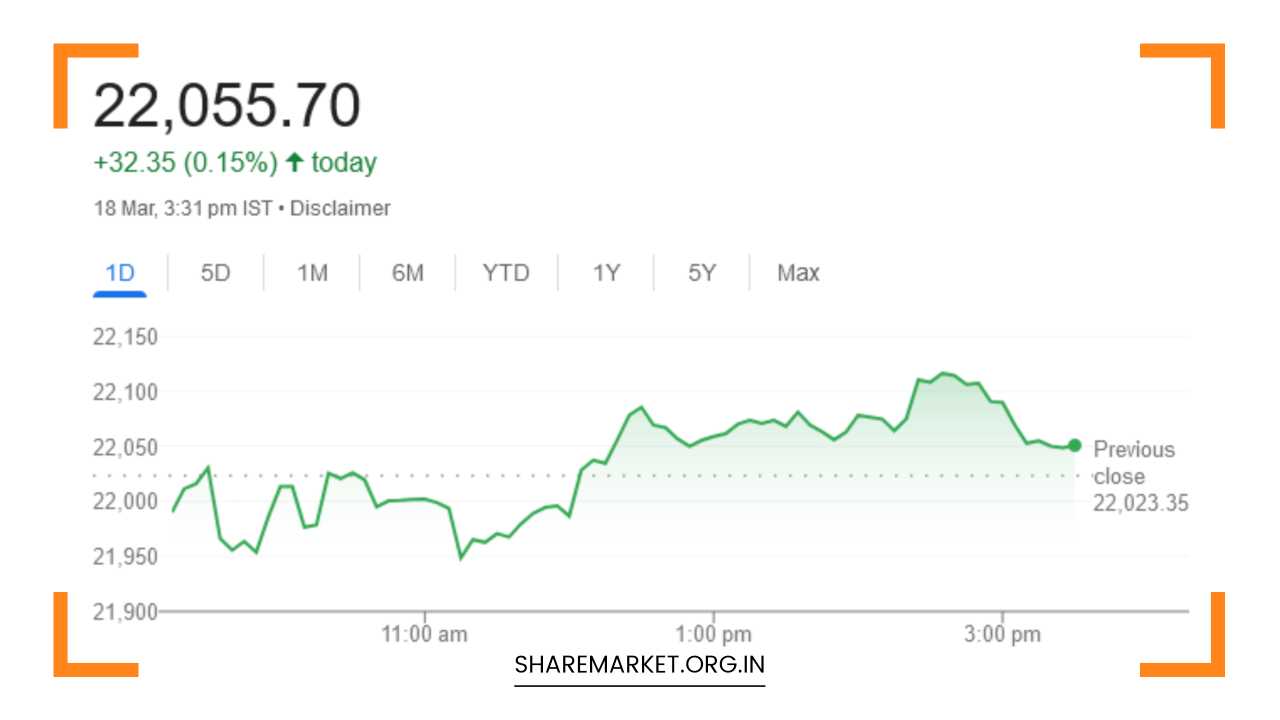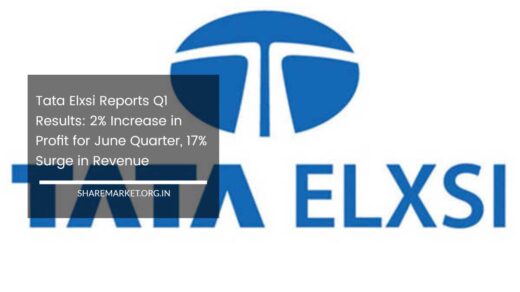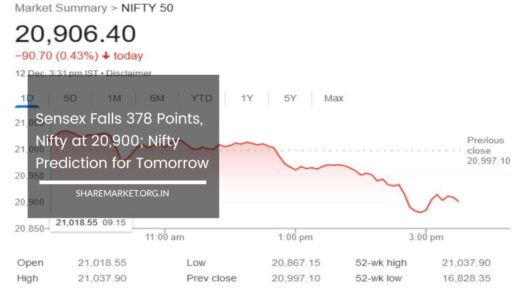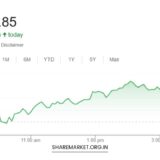Nifty Closed at 22,055.70; Nifty Prediction for Tomorrow

Nifty Prediction for Tomorrow
Indian Stock Market Analysis: March 18, 2024 – A Day of Resilience and Selective Strength
The Indian stock market on March 18, 2024, showcased a captivating display of resilience. Despite an initial wobble marked by bearish sentiment, the benchmark indices, Sensex and Nifty, managed to claw their way back to positive territory by the closing bell.
This report delves into the day’s intricate market movements, analyzing gainers, losers, sectoral performances, expert insights, and the crucial factors shaping the market’s near-term outlook.
A Tale of Two Halves: A Volatile Start and a Measured Recovery
The opening session on March 18th painted a picture of apprehension. Nifty, the broader market index, witnessed a gap-down opening, slipping below the psychologically important 22,000 mark and testing its support level around 21,900.
This initial decline echoed concerns about global market uncertainties and potential profit booking by some investors. However, the tide quickly turned as the trading session progressed. Key sectors like metals and autos emerged as unexpected heroes, displaying robust performances.
This resurgence, fueled by a combination of factors like rising metal prices and positive production forecasts for auto companies, propelled Nifty back above the 22,000 mark.
The index eventually settled at 22,055.70, a marginal decline of 0.15%. Similarly, Sensex closed the day at 72,748.42, down by a mere 0.14%.
Leaders and Laggards: A Sectoral Spotlight
The day witnessed a compelling mix of prominent gainers and surprising laggards. Among the Nifty champions, Tata Steel stood out with a stellar performance, surging over 5%.
This upswing can be attributed to the recent rally in global steel prices, driven by a confluence of factors like supply chain disruptions and rising demand from key construction sectors. M&M, JSW Steel, Tata Motors, and Apollo Hospitals also joined the ranks of the top gainers, each witnessing significant growth throughout the session.
Conversely, established players like Tata Consumer Products and UPL found themselves on the losing side. The decline in Tata Consumer Products could potentially be linked to concerns about slowing rural demand in India.
UPL, a prominent agrochemical company, might have been weighed down by profit-booking after a recent strong run. Infosys, Adani Ports, and Titan also featured among the Nifty losers, reflecting a more cautious investor approach towards the IT and FMCG sectors.
A Divergent Landscape: Sectoral Performances in Detail
Equity sectors displayed a fascinating degree of divergence. Capital Goods emerged as the undisputed champion, surging by a noteworthy 3%.
This growth could be attributed to optimism surrounding upcoming infrastructure projects and potential government spending in this sector.
Healthcare, Auto, Realty, Metal, and Media also displayed resilience, with each sector witnessing gains ranging from 0.5% to 2%. However, the IT and FMCG sectors experienced declines of 0.5% to 1.5%, reflecting a more cautious investor sentiment.
The IT sector might be grappling with concerns about global tech stock valuations and potential headwinds from a slowing global economy.
The decline in the FMCG sector could be linked to anxieties about a potential slowdown in rural demand, which is a crucial market for these companies.
Expert Opinions: Decoding the Market’s Moves
Market analysts weighed in on the day’s events, offering valuable insights. Aditya Gaggar, Director at Progressive Shares, highlighted the initial bearish dominance but emphasized the swift recovery led by key sectors like metals and autos.
He pointed out that this resurgence is evidence of underlying strength in specific segments of the market, particularly those benefiting from specific tailwinds. Jatin Gedia of Sharekhan echoed similar sentiments, noting Nifty’s successful consolidation within a specific range (21,900-22,200) and its reliance on crucial support levels.
Both experts emphasized the importance of a breakout beyond this range, as it could determine the market’s future direction.
A breakout above 22,215-22,250 could signal a potential uptrend, while a sustained decline below 21,900-21,860 could indicate a bearish continuation.
Looking Ahead: A Cautiously Optimistic Outlook
Moving forward, market participants hold a cautiously optimistic outlook. Key resistance and support levels are identified for Nifty, with a breakout beyond these ranges acting as a potential turning point.
Additionally, Bank Nifty, despite experiencing its seventh consecutive closing in the red, exhibited signs of resilience during the intraday session, rebounding from its lows.
Analysts anticipate a potential uptrend in the banking sector if it can overcome the current resistance level around 46,300. This potential turnaround in the banking sector could be a positive indicator for the overall market health.
Factors Shaping the Market Narrative
Beyond the immediate events of March 18th, several crucial factors are shaping the narrative of the Indian stock market and influencing investor sentiment. Here’s a closer look at some of the key considerations:
-
Global Economic Landscape: Concerns about a potential global economic slowdown linger, with factors like rising inflation and tightening monetary policies in developed economies impacting investor confidence. The Indian market is not immune to these external headwinds, and investors are closely monitoring global economic data releases and central bank actions.
-
Geopolitical Tensions: Ongoing geopolitical tensions, particularly the conflict in Ukraine, continue to disrupt supply chains and exert upward pressure on commodity prices. This can have a cascading effect on various sectors within the Indian market, with sectors like metals potentially benefiting from rising commodity prices, while others, like FMCG, might face challenges due to increased input costs.
-
Domestic Growth Story: India’s domestic growth story remains a key driver of investor optimism. The government’s focus on infrastructure development, coupled with a young and growing population, presents long-term growth prospects for the Indian market. However, factors like rising domestic inflation and potential interest rate hikes by the Reserve Bank of India (RBI) could dampen investor enthusiasm in the near term.
-
Corporate Earnings Season: The upcoming corporate earnings season will be a critical event for the market. Strong corporate earnings reports can bolster investor confidence and trigger positive sentiment, while disappointing results could lead to profit-booking and corrections.
-
Foreign Institutional Investor (FII) Activity: Foreign Institutional Investor (FII) activity plays a significant role in influencing the Indian market. Net inflows from FIIs can provide liquidity and support market rallies, while net outflows can exert downward pressure. Monitoring FII activity will be crucial in gauging investor sentiment from abroad.
Investment Strategies in a Volatile Market
Given the current market volatility, here are some potential investment strategies to consider:
-
Sectoral Rotation: Investors can consider rotating their portfolios towards sectors that are expected to benefit from the current market environment. For instance, focusing on sectors like metals or capital goods that might be buoyed by global trends could be a strategic move.
-
Diversification: Maintaining a well-diversified portfolio across various asset classes and sectors is crucial to mitigate risk. This can help investors weather market fluctuations and achieve their long-term financial goals.
-
Systematic Investment Plans (SIPs): Investing through Systematic Investment Plans (SIPs) can be a prudent strategy for long-term investors. SIPs allow for disciplined and regular investment, averaging out the cost of acquisition in a volatile market.
-
Focus on Quality: Focusing on companies with strong fundamentals and a proven track record of consistent growth can be a sound strategy during uncertain market conditions. These companies are generally better equipped to navigate market volatility and deliver long-term shareholder value.
Final Remarks: A Market Poised for Selective Growth
The Indian stock market on March 18, 2024, presented a microcosm of the larger market environment – a mix of initial volatility, sectoral strength, and underlying resilience. While broader concerns persist, specific sectors are demonstrating promise.
By staying informed about global developments, domestic growth drivers, and upcoming events like the earnings season, investors can make informed decisions and navigate the current market climate effectively.
Remember, a well-defined investment strategy, coupled with a long-term perspective, can be instrumental in navigating volatile market conditions and achieving financial goals.

















